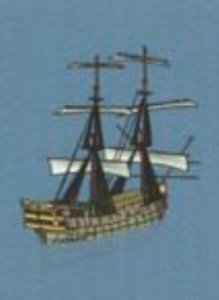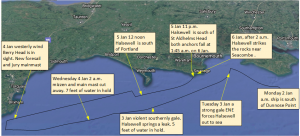The Final and Fateful Journey
The Halsewell then hit the St Aldhelm’s Head tidal race, they lowered the sail, lowered the Bower or Bough anchor, this held the ship for about an hour. They then lowered the Sheet anchor, an emergency anchor, this held the ship for another two hours.
The Fateful Journey
On Tuesday the 3rd, after the ship had laid at anchor for seven hours, at four in the morning, a strong gale came in from the East-North-East and the ship began to drag its anchor, they then had to cut their cables and the ship went further out to sea; the cables comprised of three plated ropes extracted from hemp or cannabis31.
At noon they transferred their Pilot to a Brig bound for Dublin.
At 8 pm, the wind from the south was increasing and they adjusted their sail appropriately.
At 10 pm the southern wind became a violent gale and they trimmed their sale to a minimum to ensure the ship would keep off shore. This presented an issue with the Hawse Holes, apertures at the helm of the ship, that allows the anchor cables access, due to a recent modification prior to sailing. The Hawse Plug, a conical- shaped canvas bag was installed from the internal side of the bough and lacked the advantage of the manually external applied plugs, where the waves wedged the Hawse Plug into the hole31. When they had lost their protective hawse plugs the sea water flooded onto the Gun Deck and into the bilge well at the bottom of the hull.
The well was sounded and the depth was five feet, on investigation a more serious issue was apparent, the hull has sprung a leak. The weight of this extra water would have made the ship sail lower in the water, the height of the freeboard would be reduced making Halsewell more prone to waves washing over her decks, endangering her and more likely to heel the ship, allowing more water onboard28.
Some crew members manned the manual pumps and attempted to remove the sea water to ensure the ship did not heel over. This situation became desperate at 2 am. At this juncture the captain attempted to slow the ship by gybing – this involves pushing the back (or stern) of the boat through the wind, effectively the opposite to the tack manoeuvre. This was unsuccessful. Generally, when confronted with gale force winds the captain’s response was to reduce sail31. The mizzen mast, behind or aft of the main mast sail was taken down, but this did not slow the ship as it approached the entrance to Lyme Bay. At this point there was seven feet of water in the bilge well and to stop the ship foundering the main mast was cut away along with the crew rigging the main sail, the Cockswain and four other crew were drowned in the event36.
On Wednesday the 4th January, at 8 am, the ship got before the wind and made progress for two hours, the crew had decreased the bilge water from seven to five feet using the hand driven pumps, located at the base of the main mast in an area named the pump well.
The pumps were two vertical elm cylinders that stretched from the bilge well to the open deck. Inside each tube was a piston, operated by a large lever at the top. The pumps worked by the application of suction and force this raised water from the well to the upper deck and then to the sea. The levers were manned by several men on each lever, it was a strenuous task that required teams of men working in relays to ensure pumping continued uninterrupted. On Nelson’s Victory it was said that thirty men could pump 120 tons of water an hour or two tons of water a minute31. In the case of the Halsewell there was a dispute between the officers and seamen, this culminated in some men refusing to take their turn on the pumps, so the previous two tons a minute figure was easily halved. The men who willing manned the pumps were soon exhausted and Captain Peirce made a request for help from the soldiers, a team of recruits were pressed into service, but these were malnourished and were not physically fit, suffering from the cold and seasickness. Eventually, Peirce’s own officers stepped in to replace them31
At 10 am the wind had dropped causing the fore top-mast over onto the port side, in the fall the mast went through the fore sail and tore it to pieces.
At 11 am the wind changed and blew from the west and the sky cleared allowing the captain to see Berry-Head an east facing headland at the south of Tor Bay, Devon, bearing North and by East 11 degrees 25 minutes East of North at a distance of five leagues or 15 miles. The crew secured another For-sail to the yard arm, erected a jury or makeshift main mast and set a top Gallant-sail for a Main-sail. They now attempted to sail back to Portsmouth for repairs36On Thursday 5th January at 2 am, the wind direction changed to a South, blew fresh and snowed. At noon Portland Bill was visible bearing North and by East at a distance of two to three leagues or six to nine miles.
At 8 pm the south wind increased to a strong gale and Portland Bill was at a bearing 45 degrees West of North at a distance of four to five leagues, they made slow progress to the east. The captain’s objective was to safely negotiate Peveril Point, Swanage and anchor the ship in Studland Bay, this would protect the ship from the prevailing southernly wind.
At 11 pm the sky cleared and they were able to see St Aldhelm’s Head, two miles south of Worth Matravers, Swanage, at a distance of half a league or one and a half miles.
The Halsewell then hit the St Aldhelm’s Head tidal race, they lowered the sail, lowered the Bower or Bough anchor, this held the ship for about an hour. They then lowered the Sheet anchor, an emergency anchor, this held the ship for another two hours. During this entire period Halsewell swirled fiercely around in a clockwise direction and the Guns of Distress were fired. When the last anchor failed the ship was propelled even further to the rocks surrounding Winspit; the Guns of Distress were cannons, to alert those onshore to their predicament.
Finally, the battle against the elements was lost and the ship foundered on to the rocks at 2 am on Friday 6th January 1786. The timing of the arrival at St Aldhelm’s Head could not have been worst. The tide had turned at 7 pm – 8pm and a flood tide had begun to surge up the English Channel, it was running at its maximum speed of two knots at 10 pm and continued to flow in a north Westerly direction until 2 am on the 6th January.
The St Aldhelm’s Head ledge, runs out into the sea for between 3.5 and 5 miles offshore in south- westerly direction and creates overfalls; turbulent stretches of open water caused by a strong current or tide running over the submerged ridge28.


